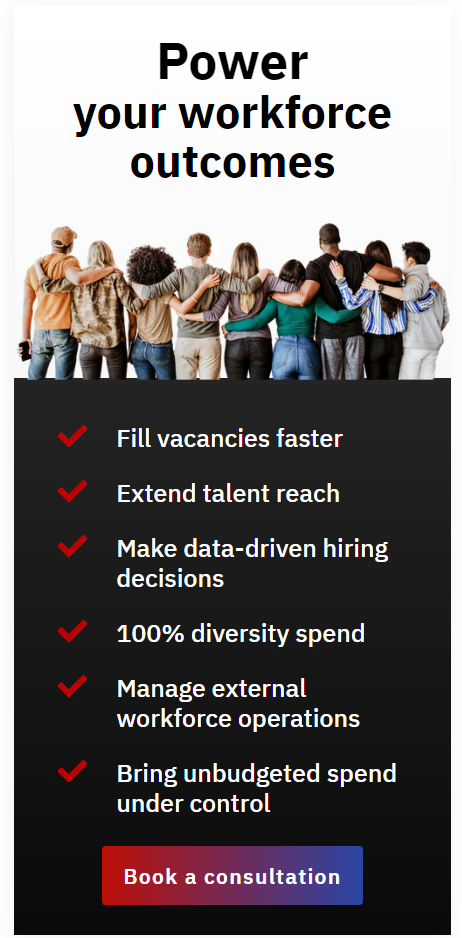Did you know that over 62% of organizations report that contingent workers make up more than 40% of their talent, and 73% plan to increase this portion of their workforce in the next year?
Since the pandemic, there has been a clear shift towards maximizing contingent talent, but, as the tides have changed, workers have more choices than before. This means that employers now have to do more to attract top talent; they have to be competitive.
In this article, we try to answer the big question that’s bouncing around the talent industry at the moment: ‘How can my organization attract and hire contingent talent in the midst of a talent shortage?’
Where to find contingent talent?
Before you consider attracting contingent workers, you first need to decide which method you will use to connect with them.
Direct sourcing
This is becoming the ride or die solution for finding contingent workers. If you haven’t thought about using direct sourcing to source your contingent talent, now is the time to start.
The point of direct sourcing is using your brand and its influence to attract contingent talent to build your talent pool, instead of going through indirect staffing vendors.
According to SIA, 62% of enterprise organizations that use contingent workers have either implemented a direct sourcing program or plan to in the near future.
So DS is a popular choice, and a good choice at that. Direct sourcing also helps organizations cut hiring costs and improve recruitment metrics, whilst having easy access to a diverse pool of talent.
Job advertisements
This is a pretty obvious one. You can do this on a variety of sites, including LinkedIn. However, with there being a talent shortage, it is time to re-evaluate your job advertisements. Are they doing you any favors?
Firstly, start with the job specification. If you’re asking for a candidate to meet too many skills, you may be narrowing your talent pool too much. Instead of expecting a 100% match to these skills, it would be much easier to find talent that fits 70/80%, increasing the number of potential candidates.
Similarly, a skill-based approach may be the way to go. Skill-based hiring is essentially forgetting about the degree, and focusing on the candidate’s skills and experience. Higher education is expensive, so don’t make it a fundamental requirement for your contingent workers. If they meet your requirements, but do not have a degree, what do you have to lose?
Additionally, you need to be ‘sell’ your organization and be as transparent as possible. Show that you’re a diverse business, and list all the benefits that your successful candidates can expect. But most of all, demonstrate what makes your company exciting to work for.
Making your organization attractive
Treat contingent workers similar to employees
More often than not, contingent workers want to be treated in the same way as full-time employees. This can be achieved in a variety of different ways, but it’s important to understand that they should have the same or at least the majority of benefits employees receive.
Benefits may include:
- Health insurance
- Well-being support
- Training
- Overtime
- Paid time off
- Flexible working opportunities
This is completely at your discretion, as you may wish to set yourself apart by providing benefits that your competitors wouldn’t typically offer. Thus, your organization becomes a more attractive place to work, enticing contingent workers who want these kinds of benefits.

In 2022, 77% of organizations worldwide report experiencing talent shortages.
Skills/career growth
Providing opportunities for career growth has the potential to make your organization more attractive to contingent talent. Previously, workers used to care more about pay than any other factors, however that has changed. That is not to say pay isn’t important, but there are now other factors to consider.
In roles where specific skills are required, it would benefit your organization to up-skill and provide in-house training for both contingent and permanent workers. This not only helps people build their careers long-term, but also helps you fill skill gaps in your workplace.
If workers consider whether to work for your organization or not, seeing that you’re willing to invest in the progression of their careers may swing their decision in your favor.
Diversity and Inclusion
It’s essential to start thinking about D&I in relation to the contingent workforce, and how it increases your attractiveness to new workers. Not only that, recruiting from a diverse pool of candidates increases the likelihood that you’ll find the best-suited worker for your organization.
Today workers consider diversity an important part of their decision to apply for roles, particularly Millennial and Gen Z workers. Therefore, rethinking your diversity and inclusivity goals needs to be a priority.
How to create a diverse workforce:
Hire from diverse staffing suppliers
Working with diverse suppliers can greatly boost your D&I initiatives, giving you access diverse talent that meets your specifitations.
Include contingent workers in your company culture
Provide all your workers (both permanent and contingent) with D&I training to improve general awareness and incorporate them into your company culture.
Make conversation
When it comes to diversity, put in the effort to take worker’s concerns, suggestions, and ideas into account. Making people feel heard does wonders for making your workforce feel valued. It also helps you realign D&I initiatives, turn words into action, and boost retention.
It’s no secret that diversity is a competitive advantage for companies looking to attract talent. Find out more about the benefits of working with a diverse supplier, in this article.
Final Thoughts
Finding top talent during a talent shortage can be difficult, and the contingent workforce promises to bridge that gap in the search for workers. But the competition for talent is still forging forward, and attracting workers continues to be a challenge.
Overall, workers want to feel valued by the organizations they work for, whilst being provided with suitable employee benefits and satisfactory compensation. So, it’s important to rethink your approach to how you advertise your jobs and your business, in order to meet these needs. Consider what value your company brings workers and use that to market yourself to that audience. It’s not just a matter of, ‘are they the right candidate for the job?’, but ‘is your organization the right company for them to work for?’

Chloe Mumford
Author



